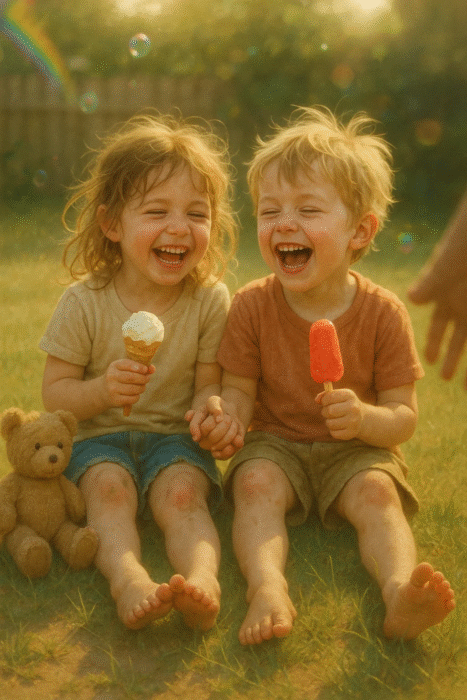Inner Joy vs. Outer Pleasure — What Lasts Longer? The Secret to a Truly Happy Life
| Focus Theme : Mindset, Gratitude, Positivity |
Series III Inner Joy Part 10/5
Introduction: When the Highs Fade
That new car smell fades. The thrill of a promotion wears off. Even the “perfect” relationship eventually hits rough patches. If outer pleasures don’t last, what actually creates a happy life?

We live in a world designed to make us chase: the next gadget, the next trip, the next big milestone. And while these moments deliver excitement, they often slip away faster than we expect—leaving us restless, searching for the next “fix.”
Here’s the truth: sustainable happiness isn’t about chasing fleeting highs. It’s about cultivating inner joy—a quiet flame that outlasts circumstances. Inner joy doesn’t need likes, luxury, or applause. It’s rooted in meaning, connection, and growth.
Science reveals that a happy life is built on internal foundations, not external validations. When we confuse pleasure for happiness, we set ourselves up for exhaustion. But when we choose joy, we build resilience that carries us through highs and lows alike.
This blog will explore the difference between pleasure and joy, why society trains us to chase the wrong one, and what neuroscience says about cultivating lasting happiness. Most importantly, you’ll walk away with tools to stop chasing fireworks and start enjoying constellations.
Defining the Difference: Why Your Brain Confuses Pleasure With Happiness
Pleasure and joy both feel good—but they live in different parts of the brain and shape your happiness in different ways.
Outer Pleasure (Dopamine-Driven)
Outer pleasure comes from quick hits: a shopping spree, social media likes, fast food, or binge-worthy TV. These experiences activate dopamine—the brain’s “reward” chemical. Dopamine spikes feel exciting but crash quickly, leaving us craving more.
A study published in Nature Neuroscience (2018) confirmed that these dopamine-driven rewards can actually increase restlessness, making us more prone to addictions and impulsive decisions. Pleasure feels good in the moment but doesn’t last.
Inner Joy (Serotonin & Oxytocin-Based)

Inner joy, on the other hand, is slower, deeper, and more sustainable. It comes from practicing gratitude, forming close relationships, or immersing yourself in creativity and flow. This activates serotonin and oxytocin, chemicals associated with stability, bonding, and long-term well-being.
Harvard’s famous Study of Adult Development, which followed people for over 80 years, revealed a powerful truth: life satisfaction peaks when people prioritize relationships and meaning over excitement. In fact, those who nurtured inner joy reported higher happiness levels well into old age.
👉 A happy life requires rewiring what we chase. Pleasure is a spark. Joy is the flame.
The Trap of Modern “Happiness”: How Society Sells You Short-Term Fixes
We’re surrounded by messages that blur the line between pleasure and happiness.
- Consumerism: Advertisements equate happiness with ownership. “Buy this phone, and you’ll feel connected.” “Wear this brand, and you’ll belong.” But once the novelty wears off, the void reappears.
- Social Media: Platforms sell “performative happiness.” Smiles, filters, and curated lifestyles become substitutes for authentic joy. This comparison trap leaves us anxious and unfulfilled.
Case Study: Denmark is consistently ranked one of the happiest countries. Their secret? Hygge—a cultural value of coziness, presence, and simple joys like shared meals. Compare that to America’s burnout culture, where overwork and consumption drive life, and you’ll see why chasing pleasure alone leaves people empty.
The Science of Lasting Joy: Rewiring Your Brain for Happiness
Neuroplasticity of Happiness
The brain is trainable. Studies in Psychiatry Research (2021) show that just 8 weeks of meditation increases the size of the prefrontal cortex—the area responsible for self-awareness and emotional regulation. In other words, practicing inner joy literally rewires your brain for resilience.
The 3 Pillars of Inner Joy

- Autonomy
Joy grows when you choose alignment over approval. Saying no to a toxic job or unhealthy relationship creates space for peace. - Connection
UCLA research shows that a 7-second hug releases oxytocin, lowering stress and strengthening bonds. Relationships, not rewards, drive long-term happiness. - Growth
The Journal of Positive Psychology found that learning a new skill provided more satisfaction than buying a new gadget. Progress, not possessions, fuels purpose.
Joy in Action: Real People, Real Stories
- A CEO left the corporate grind to teach yoga: “I traded stress for sunrise serenity.”
- A minimalist artist found bliss not in possessions but in creating.
👉 Inner joy is the quiet architect of a happy life.
How to Shift From Pleasure to Joy: Rewiring Your Daily Habits
If you want a happy life, you need to train your brain to crave joy more than pleasure. Here’s how:
- The 5-Minute Rule: Before buying or indulging, ask: Will this nourish me tomorrow—or just tonight?
- Gratitude Loops: Each night, list three things you’re grateful for. Gratitude rewires your brain to focus on abundance instead of lack.
- Digital Boundaries: Create “Joy Hours” with no screens—cook, dance, or talk with someone you love. Real presence beats virtual pleasure every time.
Quote to live by: “Outer pleasure shouts. Inner joy whispers—but its voice carries farther.”
Conclusion: Fireworks or Constellations ?
Outer pleasures are like fireworks—bright, thrilling, but fleeting. Inner joy is like constellations—quiet, steady, and always there when the noise fades.
A happy life doesn’t come from collecting more—it comes from cultivating what lasts: presence, connection, and growth.
Tonight, replace one “like” with one real laugh. Call a friend, dance in your kitchen, or write down a dream you’ve been ignoring. 🌿 Share your #InnerJoyWin in the comments.
🌿 Because a happy life isn’t found—it’s built, one intentional moment at a time.
Leave a Reply